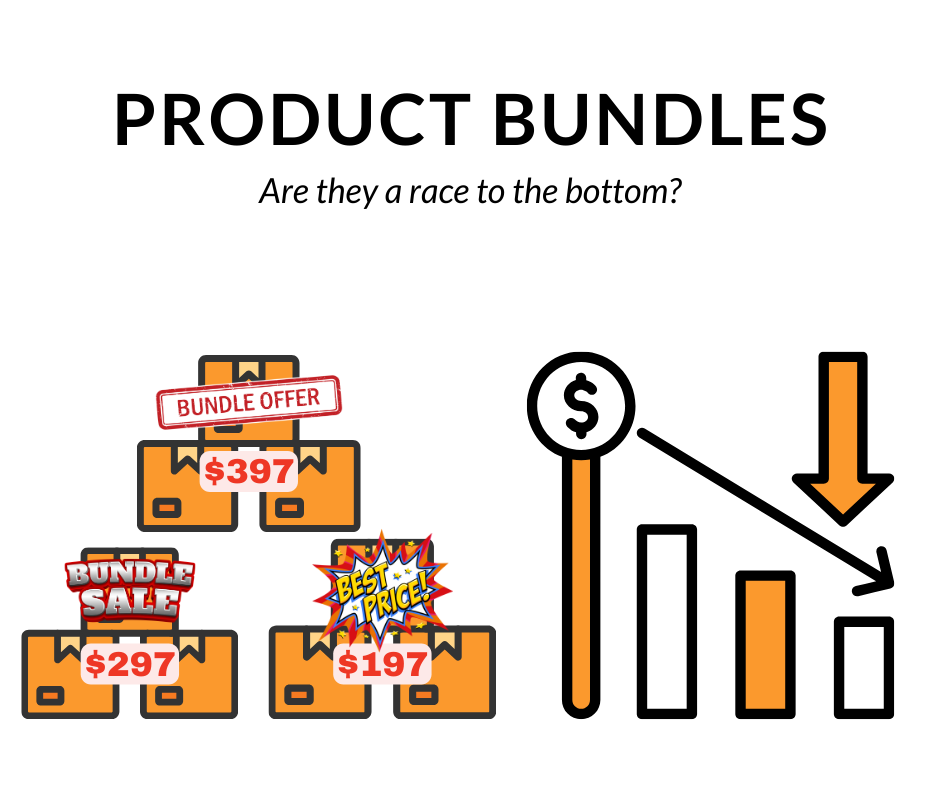
In today’s competitive marketplace, there’s a common assumption that when one marketer succeeds with a strategy, others can replicate and improve upon it—often by lowering prices. This mindset has led to the widespread practice of product bundling, where multiple products are grouped together and sold at a price lower than the competition’s last bundled offer. While this may seem like a winning strategy at first glance, it can lead to significant drawbacks for businesses, customers, affiliates, and entire industries.
The Cycle of Decreasing Prices

Product bundling can quickly become a race to the bottom. As each company tries to outdo the other by lowering their bundle prices, profit margins begin to shrink. In an effort to remain competitive, companies might bundle more products and further slash prices. While customers might appreciate these lower prices in the short term, this approach often comes at a long-term cost that impacts everyone involved.
Unsustainable Business Practices

When prices are driven too low, product owners struggle to maintain the quality and support that customers expect. The financial strain makes it difficult for businesses to invest in product development and customer service, leading to untrained support staff and even the use of poorly programmed bots to handle customer inquiries. As a result, customer satisfaction declines, and brand reputations suffer.
Moreover, when companies cannot sustain operations due to razor-thin margins, they may cut corners, sacrificing product quality and support. This erosion of quality leads to an overall decline in customer trust and satisfaction. Customers might still expect the same level of service and quality they were accustomed to but find themselves disappointed, ultimately turning to competitors or abandoning brands altogether.
Misguided Customer Expectations
The cycle of decreasing prices not only affects businesses but also alters consumer behavior. Customers are conditioned to expect rock-bottom prices without understanding the impact on quality and service. This misconception encourages a market where the cheapest option is seen as the best choice, neglecting the value of premium products that offer superior quality and support.
Damage to Affiliate Relationships
The impact of reduced pricing strategies extends to affiliate relationships as well. Affiliates, who play a crucial role in promoting and selling products, often earn commissions based on the sale price. As prices drop due to aggressive bundling, affiliates find themselves earning smaller commissions for the same amount of effort, which can lead to dissatisfaction and decreased motivation to promote the products.
Furthermore, affiliates rely on promoting high-quality products that provide value to their audiences. When brands sacrifice quality for lower prices, affiliates may face reputational risks if the products they recommend don’t meet customer expectations. This can damage the trust affiliates have built with their audiences, leading to lost opportunities and strained relationships with both customers and the brands they promote.
The Damage to Brands and Industries

Ultimately, this pricing strategy can harm brands and entire industries. When businesses rely on short-term marketing tactics that lack sustainability, they risk damaging their reputation and long-term profitability. Industries that once thrived on innovation and quality can find themselves struggling under the weight of customer expectations for low prices and high quality—an often unattainable combination.
By focusing solely on price, companies may lose sight of what truly sets their products apart. The emphasis on being the cheapest option can overshadow the unique features and benefits of a product, leading to a lack of differentiation in the market. This shift away from innovation and quality can stifle creativity and ultimately result in a homogenized industry where products are indistinguishable from one another.
The Path Forward: Quality Over Quantity
Instead of succumbing to the temptation of reducing prices through bundling, businesses should focus on showcasing the unique benefits and quality of their products. Educating customers on why a higher price point can deliver better value is essential. Companies can foster brand loyalty and ensure long-term success by emphasizing innovation, quality, and exceptional customer service.
Investing in quality marketing strategies that highlight a product’s strengths can differentiate a brand from its competitors and attract discerning customers who are willing to pay for superior offerings. By aligning marketing efforts with a commitment to excellence, businesses can cultivate a loyal customer base that appreciates the value of their products beyond just the price tag.
Conclusion
Product bundling for reduced pricing might offer short-term gains, but it’s ultimately a race to the bottom that benefits no one in the long run. By prioritizing quality, innovation, and sustainable practices, businesses can build stronger brands, maintain healthy affiliate relationships, and contribute to healthier industries. After all, when it comes to value, quality should always outweigh quantity.

